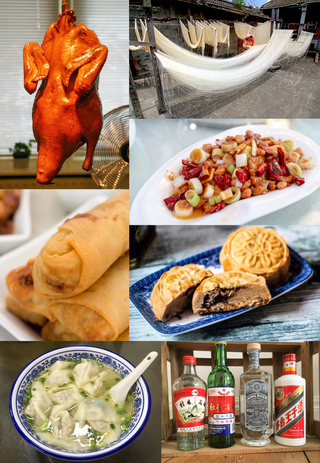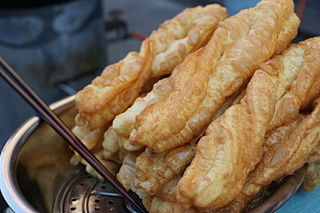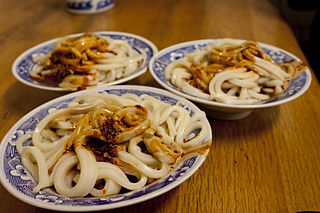
Chinese cuisine comprises cuisines originating from China, as well as from Chinese people from other parts of the world. Because of the Chinese diaspora and the historical power of the country, Chinese cuisine has profoundly influenced many other cuisines in Asia and beyond, with modifications made to cater to local palates. Chinese food staples such as rice, soy sauce, noodles, tea, chili oil, and tofu, and utensils such as chopsticks and the wok, can now be found worldwide.

Thai cuisine is the national cuisine of Thailand.

Hot dry noodles, known in Chinese as reganmian, is a traditional dish of Wuhan, the capital of Hubei province in central China. Hot dry noodles have an 80-year history in Chinese food culture; they are unique because the noodles are not in a broth like most other Asian-style hot noodle dishes. They are the most significant, famous and popular breakfast food in Wuhan, often sold by street carts and restaurants in residential and business areas. The price is between 4-6 yuan. Breakfasts such as hot dry noodles are available from about 5 am, These noodles can be prepared within minutes and are affordable, so they are a popular breakfast. There are hot dry noodle restaurants all over the city.

Youtiao, known in Southern China as yu char kway, is a long golden-brown deep-fried strip of wheat flour dough of Chinese origin and also popular in other East and Southeast Asian cuisines.

Momos are a type of steamed filled dumpling in Tibetan and Nepali cuisine that is also popular in neighbouring Bhutan, Bangladesh, and India. The majority of Tibetan momos are half-moon in shape like jiaozi, while Nepali momos are normally round like baozi. Momos are usually served with a sauce known as achar influenced by the spices and herbs used within many South Asian cuisines. It can also be used in soup, as in jhol momo and mokthuk.

Noodle soup refers to a variety of soups with noodles and other ingredients served in a light broth. Noodle soup is a common dish across East Asia, Southeast Asia and the Himalayan states of South Asia. Various types of noodles are used, such as rice noodles, wheat noodles and egg noodles.

Korean Chinese cuisine, also known as Sino–Korean cuisine, is a hybrid cuisine developed by the ethnic Chinese in Korea.

Indian Chinese cuisine, Chinese Indian cuisine, Indo-Chinese cuisine, Sino-Indian cuisine, Chindian cuisine, Hakka Chinese or Desi-Chinese cuisine is a distinct style of Chinese cuisine adapted to Indian tastes, combining Chinese foods with Indian flavours and spices. Though Asian cuisines have mixed throughout history throughout Asia, the most popular origin story of the fusion food resides with Chinese labourers of Calcutta, who immigrated to British India looking for work. Opening restaurant businesses in the area, these early Chinese food sellers adapted their culinary styles to suit Indian tastes.

Nokdu-muk is a Korean muk, or jelly, made from mung bean starch. In its most commonly encountered form, it is also called cheongpo-muk, which literally means "clear froth jelly," owing to its clear white color. If it is colored with gardenia, the nokdu-muk is called hwangpo-muk, which literally means "yellow froth jelly."

Japanese Chinese cuisine, also known as chūka, represents a unique fusion of Japanese and Chinese culinary traditions that have evolved over the late 19th century and more recent times. This style, served predominantly by Chinese restaurants in Japan, stands distinct from the "authentic Chinese food" found in areas such as Yokohama Chinatown. Despite this difference, the cuisine retains strong influences from various Chinese culinary styles, as seen in the shippoku cooking style.

Shaanxi cuisine, or Qin cuisine, is derived from the native cooking styles of Shaanxi Province and parts of northwestern China.

A soy egg is a type of egg in Chinese, Vietnamese, Japanese, Korean, and Mauritian cuisine which is boiled, peeled, and then cooked in a mixture of soy sauce, sugar, water, and other optional herbs and spices, like star anise or cinnamon. Other ingredients such as meat, vegetables and tofu can be cooked in the same red cooking method, resulting in dishes generally referred to as lou mei. Soy eggs can be made from chicken, duck, and quail eggs.

Tteokbokki (Korean: 떡볶이), or simmered rice cake, is a popular Korean food made from small-sized garae-tteok called tteokmyeon or commonly tteokbokki-tteok. Eomuk, boiled eggs, and scallions are some common ingredients paired with tteokbokki in dishes. It can be seasoned with either spicy gochujang or non-spicy ganjang -based sauce; the former is the most common form, while the latter is less common and sometimes called gungjung-tteokbokki.

Mixian is a type of rice noodle from Yunnan Province, China. These noodles are typically distinguished by their round shape, moderate thickness, and smooth, silky texture. They are normally used fresh and are commonly seen in stir-fry recipes, often served with rich broths and sauces.

Liangpi is a Chinese dish composed of cold noodles made from wheat or rice flour. It is a specialty dish originating from the cuisine of Shaanxi Province, but has now spread throughout China. In northwestern areas of China, it is often called liangpi zi (凉皮子). Although liangpi is served cold, they are served in every season, including winter.

Liangfen, also spelled liang fen, is a Chinese legume dish consisting of starch jelly that is usually served cold, with a savory sauce, often in the summer. It is most popular in northern China, including Beijing, Gansu, and Shaanxi, but may also be found in Sichuan and Qinghai. In Tibet and Nepal it is called laping and is a common street vendor food. In Kyrgyzstan it is an ingredient in a noodle dish called ashlan fu.

Dandan noodles is a Chinese noodle dish originating from Sichuan cuisine. It consists of a spicy sauce, usually containing pickled vegetables such as zha cai or ya cai, as well as chili oil, Sichuan pepper, minced pork, and scallions served over noodles. The dish can either be served dry or as a noodle soup.

Hot and sour soup is a popular example of Chinese cuisine. Although it is said to be originated in Sichuan, this is actually a variant of hulatang or "pepper hot soup" (胡辣汤) with added vinegar to enhance the sourness. This variation is found in Henan province, and in Henan cuisine itself. Also popular in Southeast Asia, India, Pakistan and the United States, it is a flexible soup which allows ingredients to be substituted or added depending on availability. For example, the American-Chinese version can be thicker as it commonly includes corn starch, while in Japan, sake is often added.
Cold noodles are dishes typically made out of noodles, soy sauce, cucumber, and various other ingredients. They are commonly served at room temperature with a dipping sauce on the side. The methods and ingredients used to make cold noodles vary from country to country.



















